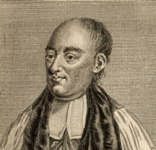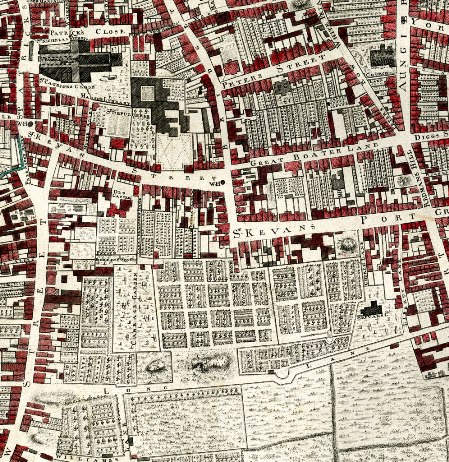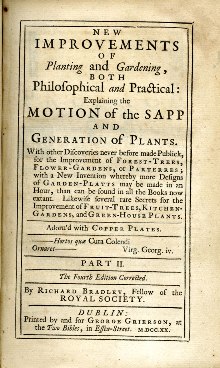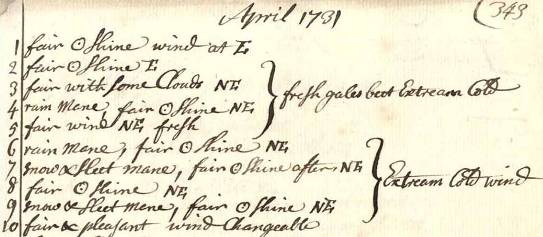Jonathan Swift’s garden
Published on 15th February 2017
 Jonathan Swift purchased his garden in 1722 and named it ‘Naboth’s Vineyard’; the name taken from the Bible (1 Kings 21). This garden was situated south of the Deanery of St Patrick’s and originally consisted of a large open field on the south side of Long Lane. In the summer of 1724 Swift spent £600 enclosing the field with a wall to protect his horses; a considerable sum which he afterwards claimed ‘will ruin both my health and fortune, as well as humor.’
Jonathan Swift purchased his garden in 1722 and named it ‘Naboth’s Vineyard’; the name taken from the Bible (1 Kings 21). This garden was situated south of the Deanery of St Patrick’s and originally consisted of a large open field on the south side of Long Lane. In the summer of 1724 Swift spent £600 enclosing the field with a wall to protect his horses; a considerable sum which he afterwards claimed ‘will ruin both my health and fortune, as well as humor.’
Image: Bust of Jonathan Swift
Writing to his friend Knightley Chetwode in February 1723 he says ‘I am as busy in my little spot of a town garden as ever I was in the grand monde… for as to politics I have long forsworn them.’ He frequently discussed gardening with Chetwode, who owned a house and estate at Woodbrooke, near Mountmellick in modern-day County Laois, which he was improving. Swift enquired after his fruit trees, apples, pears, peaches and nectarines. Another friend, Rev. Thomas Sheridan, had a house and garden at Quilca, Co. Cavan, and Swift spent time there enjoying the country and comparing notes on horticulture.
Swift's garden was situated in one of the fields south of Long Lane, shown above in Rocque's Map of 1756.
Of Swift’s use of his garden we get glimpses from his letters to friends. In the bad summer of 1725, in which ‘we have but five good days these twelve weeks’, he complains about his crop of hay, fearing that the weather had ruined it, and his apple crop is greatly reduced. He refers to his wall fruit and speaks about having the garden ‘new dunged as good husbandry requires’. He planned to build a temporary shed in a corner of the field until he could afford to build a better one in the centre.
"The weather this month so so exceedingly bad, the harvest was spoil'd, and most of the fruits and vegetable productions of the Earth" Aug 1725 from The Diary of Weather and Winds 1716-1734.
In the spring of 1727 he notes ‘I know nothing I should more desire that some spot upon which I could spend the rest of my life in improving… I have spirit still left to keep a clatter about my little garden, where I pretend to have the finest paradise stocks of their age in Ireland.’ Here we see him using his garden as a place of contentment and wellbeing, growing fruit and flowers to improve his spirits. In his library Swift had a copy of the Dublin edition of Richard Bradley’s Improvements in gardening, published in 1720. This book, in three volumes, gives advice on ornamental plants, fruit trees and kitchen gardens.
Richard Bradley, New improvements of planting and gardening, both philosophical and practical. Dublin, 1720.
Not all was rosy in the garden, in September 1728 Swift laments the havoc done to the garden by the flooding of the River Poddle. Windy spring weather in April 1731 caused his peach, nectarine and pears to suffer. It is interesting that Swift and his friends chose to grow exotic fruit trees in the unpredictable climate of Ireland. They are likely to be the wall fruit referred to. Bishop Synge, whose Dublin garden in Kevin Street was close to Swift’s, also refers to growing apricots, peaches and nectarines as well as the more robust apples and pears.
"Extream Cold wind" in April 1731 from The Diary of Weather and Winds 1716-1734.
- Harold Williams, The correspondence of Jonathan Swift (Oxford, 1963).
- Richard Bradley, New improvements of planting and gardening, both philosophical and practical (Dublin, 1720).
See Also:



